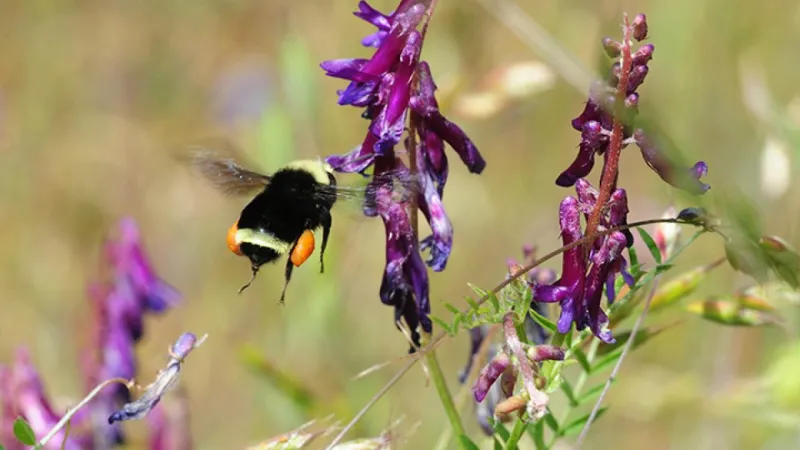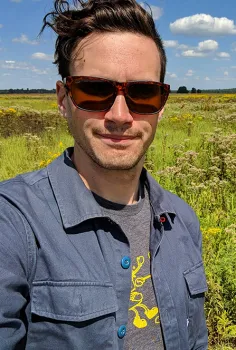Spotlighting Bumble Bee Research in the Neal Williams' Lab

UC Davis bumble bee research in the news!
The Ecological Society of America (ESA) recently spotlighted bumble bee research from the laboratory of pollinator ecologist Neal Williams, a professor in the UC Davis Department of Entomology and Nematology.
ESA singled out “Predicting Landscape-Scale Native Bumble Bee Habitat Use Over Space, Time, and Forage Availability,” for special recognition in a recent blog. The research initially appeared Feb. 14, 2025 in the journal Ecology.
The research, involving bumble bee pollen preference in a diverse, agricultural region of Northern California, is the work of Williams and former lab member Jeremy Hemberger, then a USDA NIFA postdoctoral fellow in the Williams lab, and now an assistant professor of entomology at the University of Minnesota.
The bumble bee: the yellow-faced bumble bee, Bombus vosnesenskii. Native to the West Coast of North America, it is found in both urban and agricultural habitats.

"Spurning the enormous bouquet of flowers provided by nonnative crops, California bumble bees remain steadfastly loyal to their original plant partners, suggests a recent study," the ESA blog related. "Such is their disdain for exotic pollen that in areas dominated by agriculture bees will often turn up their antennae at monoculture crops and instead search for food sources in surrounding habitat like chapparal and oak savanna, even field edges and roadside verges. The pickiness of foraging bees is a further reminder of how little we know about resource use by insects, and the importance of conserving as broad a range of natural habitats and native plant species as possible."
Williams commented that “Researchers and managers have been interested in resource use by bees across landscapes for quite a long time, and various groups have datasets on pollens used by bees. What is novel about this work is that it uses data on where plant species are growing in the landscape as well as the pollens bees are using to be able to estimate not only what they are foraging on, but also what types of habitats they are likely to be using at different times of the growing season. Of course, it is cool to see that they seem to like native plant pollens. This is not what we've always found.”
Mosaic Landscapes
n their abstract, Williams and Hemberger wrote that the results "highlight the importance of mosaic landscapes (i.e., landscape heterogeneity) in allowing bumble bees to link resources through the season." The framework they developed "also serves to enhance predictions of insect resource use within fragmented landscapes.”
"Bumble bee resource preference (i.e., pollen foraging) and availability (i.e., flowering plant abundance) are driven by the composition of the surrounding landscape and the time of year," Williams and Hemberger wrote. "Bumble bees strongly preferred pollen from native plants, which was overrepresented in samples across the season relative to its estimated availability. Our probabilistic model framework also revealed a strong reliance on semi-natural habitat in the landscape (e.g., oak savannahs, chapparal, and riparian corridors)—features that are increasingly rare in anthropogenically dominated landscapes.”

“In fact,” they wrote, “pollen resource use by colonies even in the most intensive landscapes was largely limited to interstitial habitat (e.g., field and road edges) despite available mass-flowering crops. Our results highlight the importance of mosaic landscapes (i.e., landscape heterogeneity) in allowing bumble bees to link resources through the season. The framework we develop also serves to enhance predictions of insect resource use within fragmented landscapes.”
55 Plant Species
The research team identified and counted 127,548 pollen grains from 4058 bee pollen loads across 39 sites from May 11 to July 11, 2003. Colonies collected pollen from a total of at least 55 plant species including 7 crop, 22 exotic, and 25 native species. Tomato (Solanum lycopersicum) dominated collected crop pollen. Hairy vetch (Vicia villosa) was the dominant exotic pollen, and deerweed (Lotus scoparius) the dominant native pollen collected.
"Because of the difficulty in tracking pollinators in real time, the spatiotemporal use of resources by wild pollinators is considerably understudied," they wrote. "Nonetheless such information is vital to conservation planning. Especially when used with knowledge of pollinator performance at different locations (e.g., Williams et al., 2012), it provides a mechanistic link to identify key habitats and resources for supporting pollinator populations. Thus far, the literature has largely used collections of individual bees on flowers to determine foraging preferences. Although these approaches are informative, they miss colony-level pollen use and whether use reflects plant availability in the surrounding landscape (Harmon-Threatt & Kremen, 2015; Jha et al., 2013).
Williams conceived of the experiment and conducted all field work and pollen identifications. Hemberger performed analyses and constructed data visualizations.
